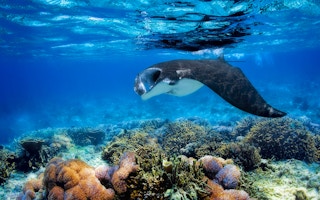Sharks and their cousins, the rays, predate the dinosaurs. They survived the catastrophic mass extinction that finished off Tyrannosaurus Rex and all the rest, as well the Permian-Triassic extinction that wiped out around 96 per cent of marine species. Even the more recently evolved shark lineages, such as the hammerheads, have been around for more than 30 million years.
To continue reading, subscribe to Eco‑Business.
There's something for everyone. We offer a range of subscription plans.
- Access our stories and receive our Insights Weekly newsletter with the free EB Member plan.
- Unlock unlimited access to our content and archive with EB Circle.
- Publish your content with EB Premium.
Yet in just a few decades, a quarter of all sharks and rays have become threatened with extinction. This is our fault – and it is our responsibility to fix it.
Shark and ray populations are not alone. Many other components of marine biodiversity – especially corals, marine mammals, seabirds, and turtles – are also struggling to withstand human pressures. As a result, marine ecosystems are at risk of unraveling and becoming less stable and less productive.
Given the broad range of threats facing marine life – including overfishing, climate change, pollution, and coastal development – it is easy, perhaps even rational, to be pessimistic. Yet this year could mark the beginning of a more robust approach to safeguarding ocean ecosystems, particularly with regard to overfishing, which is responsible for precipitous declines in many species.
The challenge ahead should not be underestimated. Meeting it will require overcoming one of the most intractable obstacles to marine conservation: ensuring the sustainability of biodiversity in the roughly 60 per cent of the world’s oceans that lie beyond the jurisdiction of individual states.
Within the 200-nautical-mile limit that comprises their exclusive economic zones (EEZs), a few countries have used a combination of strong legislation, good management, and effective enforcement to preserve fish stocks and ecosystems. (There have also been far too many counter-examples.)
Beyond the EEZs, however, a pernicious problem arises: most living resources are de facto open-access, leaving them vulnerable to overexploitation. While there have been numerous well-intentioned attempts to improve management of these resources, all rely on individual actors’ willingness to concede the short-term economic benefits of intensive resource use for the sake of the long-term common good.
Whenever a cost arises from engagement with an international process, there will always be an incentive not to play by the rules, to enforce them weakly, or not to participate at all. This is especially true for environmental issues, where the political capital required is high; the need for near-unanimous support is crucial; the issues can be contentious; and the benefits are disproportionately distributed and are realized over a long time horizon. A passing familiarity with the Realpolitik of climate change suggests that this is an intimidating – if not intractable – challenge, displaying elements of the most difficult political and social quandaries: the prisoner’s dilemma, the free-rider problem, and the tragedy of the commons.
“
Some fisheries remain outside the jurisdiction of any of the regional bodies that play a role in resource management. As a result, illegal, unreported, and unregulated fishing is worth billions of dollars per year.
At present, a web of legislation – including the United Nations Convention on the Law of the Sea, Food and Agriculture Organization guidelines, and the Fish Stocks Agreement, as well as the Convention on Migratory Species of Wild Animals – governs activities that may affect biodiversity on the high seas. Yet the protection afforded to living resources remains limited – and riddled with loopholes.
For example, because not all countries are signatories to these agreements, vessels can choose which flag to fly to avoid being bound by regulations (a “flag of convenience”). Some fisheries remain outside the jurisdiction of any of the regional bodies that play a role in resource management. As a result, illegal, unreported, and unregulated fishing is worth billions of dollars per year.
One promising step, recommended by a UN working group in January, is the development of a new, legally binding agreement on high-seas biodiversity, to be ready for the UN General Assembly to review by September.
Such a coordinated and harmonized framework may help to close regional gaps in governance; compel existing fisheries bodies to work to improve outcomes; and ultimately enable the development of new bodies that are focused on management and protection of ecosystems, not only fish stocks. That, in turn, may catalyze the cooperation needed to create high seas marine protected areas, which would enable damaged or depleted ecosystems to recover.
Of course, to be effective, such areas must be monitored. A promising development has been the use of satellite technology to detect and address fisheries violations by individual vessels. This could bring about a profound change for the better in ocean management, particularly for countries with large EEZs and limited marine enforcement capacity.
A coordinated system for responding to violations is also vital. Closing ports to vessels that break the rules could be achieved through the Port State Measures Agreement, currently awaiting ratification.
Ocean governance and conservation is at a critical juncture. Marine resources cannot be overexploited indefinitely. The forthcoming “biodiversity beyond national jurisdiction” agreement, underpinned by novel ways of monitoring compliance, could improve ocean management dramatically.
The difficulty is that, in any scenario, better management assumes that we choose long-term sustainability over short-term profits. Whether we will overcome our inclination to choose otherwise remains to be seen.
Derek Tittensor is Senior Marine Biodiversity Scientist at the United Nations Environment Program World Conservation Monitoring Center, and Adjunct Professor of Biology at Dalhousie University.
Copyright: Project Syndicate, 2015.
www.project-syndicate.org









